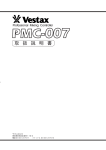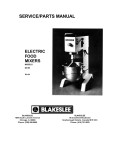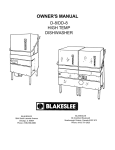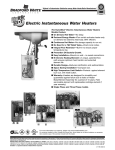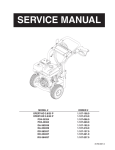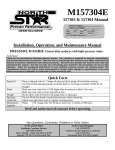Download Blakeslee UC-21 Owner`s manual
Transcript
OWNER’S MANUAL BLAKESLEE Division of Blako Inc. UNDERCOUNTER DISHWASHER UC-21 I.R.S. INTEGRATED RECIRCULATING SYSTEM DESIGN 1844 South Laramie Avenue Chicago, IL 60804 Phone (708) 656-0660 Fax (708) 656-0017 www.blakesleeinc.com [email protected] 1149 Bellamy Road North Unit 19 Scarborough, Ontario Canada M1H1H7 Phone (416) 751-2625 Fax (416) 751-8539 Date of Installation Serial No. Model No. USA Limited Warranty Your new Blakeslee dishwashing machine is warranted for one year from date of installation shown above against defective materials and workmanship. If any defects are found within the warranty period; parts, and labor involved with their replacement will be covered free of charge. Service must be performed by a Blakeslee authorized service agency. All labor to be performed during regular working hours. Overtime premium will be charged to the customer. All warranty parts are shipped by surface transportation. If other means of transportation is requested the customer is required to pay the premium. This warranty does not apply to damages resulting from errors in installation on the part of other contractors, nor does it apply to machines which have been subject to accident, misuse, or abuse. It is understood that Blakeslee’s warranty obligation with respect to machines located outside of the United States or located in the state of Alaska is limited to the furnishing of replacement parts only. In the state of Hawaii, repair labor is provided free of charge; travel time and expenses paid by the customer. On the island of Oahu, repair labor, travel time and expenses are provided free of charge. This is the entire and only warranty of Blakeslee. We neither assume nor authorize anyone else to assume for us any other obligation or liability in connection with Blakeslee Machines. • In no case can this warranty exceed eighteen (18) months from the date of shipment from our plant at Chicago, Illinois Items NOT Covered Under Warranty 1. Replacing Fuses or resetting Overloads. Replacing a blown fuse or resetting an open overload breaker is a very simple procedure and is the owner’s responsibility. If the machine continues to blow fuses or open the overload breaker, contact your nearest authorized Blakeslee Service Center. 2. Adjusting Tank Heats. Heat adjustments are covered in The Owners Manual and must be adjusted depending upon desired results. 3. Proper Loading of Dishes. It is important that the machine owner’s personnel observe the instructions outlined in The Owners Manual. 4. Cleaning Drain Valves. Foreign articles lodged in the drain valve seat should be removed as a part of the normal daily cleaning. 5. Cleaning Rinse or Wash Nozzles and Line Strainers. Keeping a dishwasher clean and removing obstructions from the nozzles and line strainers will be a periodic function of the machine owner’s personnel. The cleaning periods will vary depending upon impurities in the water supply and cleanliness of the washing operation. 6. Final Rinse Water. Most frequent of all complaints in any dishwashing machine is that of poor final rinse. It is the responsibility of the owner to provide 180 to 195 degree (plus) water at 15-25 lb. flow pressure through clean unobstructed water lines. If the machine has a factory equipped final rinse water booster, the owner must supply the booster with a minimum of 140 degree temperature water. INDEX Page 1 3 5 Section 1 Installation Instructions * Section II Operating Instructions Section III Cleaning Instructions Section IV Troubleshooting Section V Optional Equipment Section VI Illustrated Parts List SPECIFICATIONS Construction: Body of stainless steel construction throughout. MACHINE INSTALLATON DATA: Electrical: Wash System: Top and bottom counter rotating spray arms. Rinse system: Top and bottom counter rotating spray arms. Recirculating System: Gallons per minute Horsepower 180 1 Wash Tank Capacity: 6.0 gallons Volts 220 220 Phase 1 (4 wire) 3 (5 wire) Load Amps 48.6 27.0 Water Supply: Inlet Temperature Inlet Pressure * Inlet Size Inlet Flow Drain Size Water Consumption 140° F 20 psi ½” Hose 6gpm 1 ½” OD Hose 30.5 gpm Wash and Rinse Cycle Water Heating: An electric immersion heater rated at 9.0 KW heats both the wash and rinse water. Control: Automatic wash/rinse cycle control. Thermostatically controlled rinse temperature Wash Time 105 seconds Dwell Time 5 seconds Rinse Time 12 seconds Total Cycle 120 seconds * Inlet pressure should be measured at the connection point of the dish machine. SECTION I INSTALLATION The Model UC21 is suitable for both under the counter and free standing installations. Access is required to both the sides and rear of the machine for service and maintenance. Therefore, all connections should be made with flexible hoses and conduit to ensure that access can be achieved. SHIPMENT CHECKOUT & UNCRATING Unit is shipped with standard commercial packing, should any damage be observed on visual inspection of the crate; notify the freight carrier immediately, as hidden damage may exist. No special equipment is required to uncrate the unit. However care should be taken to ensure that no damage is caused by the implements used in uncrating the machinery. Level the machine by adjusting legs as necessary, while maintaining counter clearance dimensions. NOTE: If machine is not leveled properly door will not close correctly If door rubs on right side adjust right leg down or left leg up If door rubs on left side adjust left leg down or right leg up FIGURE 1 INSTALLER WARNING To protect Booster Heating Element Do not turn on electrical power supply to dishwasher until water supply has first been connected and you are ready to proceed with actual test operation of the machine. -1- WATER SUPPLY: Connect incoming water supply hose to ½” I.D. hose fitting. Water supply source must be able to provide 140°F water minimum at 20 PSI flow pressure. DRAIN: Connect 1 ½” drain tube to waste connection. Machines equipped with optional drain pump will have a ¾” hose to be inserted into an elevated drain or sink (see section 5). ELECTRICAL: Check machine data plate before making any electrical connections. All supply connections must correspond with data plate information. Check pumps rotation, pump turns clockwise when viewed from rear of motor; if not reverse leads. MODEL UC-21 UC-21T UC-21XT A 33 ¼” 39 ¼” 45 ¼” B 37 ¼” 43 ¼” 49 ¼” Dimensions A & B are ± 1” DIM. FROM FLOOR 1 2 2” LEG 6” LEG 4” 4 ½” 8” 8 ½” FIGURE 2 Size of Connection 1 140° Hot Water Connection 1/2” 2 (Check Data Plate Requirements to Correspond with Correct Power Supply) 1” 3 Drain 1 ½” Electrical Connection -2- C 12” 18” 24” D 15 ½” 21 ½” 27 ½” SECTION II OPERATION DO NOT ATTEMPT TO OPERATE WITHOUT WASH TANK BEING PROPERLY FILLED, DRY ROTATION WILL DAMAGE PUMP SEALS AND VOID WARRANTY 1. Ensure that all spray arms spin freely and that scrap tray and standpipe are properly installed. NOTE: There is no stand pipe on machines equipped with an optional drain pump. 2. Depress ON/OFF main switch to “ON” position. Switch light will indicate power is on. Close door. 3. Depress and hold START/FILL switch in the “FILL” position for 50 seconds or until water can be heard flowing down the drain. 4. If detergent is fed manually, prep full tank of fresh water with 3 oz. of a low suds commercial detergent, then 1 oz. per each cycle there after. Increase or decrease detergent rate based on results. 5. Insert rack with properly pre-scrapped and pre-flushed ware. 6. Close door, depress and hold START/FILL switch for 1 second in the “START” position. Lighted switch will indicate machine is operating. 7. Cycle is completed when START/FILL switch indicator light turns off. 8. Open door and remove rack of cleaned ware. IMPORTANT do not leave rack sitting on open door. 9. Washing operation is completed START/FILL SWITCH MAIN ON/OFF SWITCH DRAIN PUMP SWITCH (OPTIONAL) FINAL RINSE TEMPERATURE GAUGE FINAL RINSE PRESSURE GAUGE WASH TANK TEMPERATURE GAUGE ADJUSTABLE LEG FIGURE 3 -3- Observe the following instructions to obtain maximum performance from the dishwashing machine. 1. Whenever possible, instruct bus boys or wait staff to stack the soiled dishes according to sizes as they are brought to the soiled dish table. 2. Remove by hand, rubber scraper, or pre-washing as much food particles left on the dishes as possible. This will reduce pollution of water, insure the cleanest possible wash water and lower detergent costs. 3. Rack dishes in appropriate rack as indicated in figure 4. When placing silverware in combination rack; you should be able to see many holes in the bottom of the rack after it is loaded. Dishes and all “flat” china should be stacked in the multi-purpose racks so that they lean back with the face of soiled surface of the dish exposed to the upper spray. Glasses, cups, bowls and other “deep” dishes should be placed face down in the combination racks. Remember, whenever possible it is a good practice to have your bus boys or waitresses place cups, glasses and bowls directly in the combination rack. Do not overcrowd or overload the racks as the wash and rinse waters must reach all surfaces to obtain clean ware. 4. Scrape and rack more dishes and insert the racks of soiled ware into the machine. 5. Clean ware must be taken out of the racks and the empty racks removed from the clean dish table and returned to the soiled dish table for reloading. Do not let dish racks pile up on the clean dish table until they hit the end of the dish table as this subjects the conveyor to unnecessary strain. Let the washed and rinsed dishes remain in the racks for a minute or so until they have had a chance to drain and self dry. If the dishes are removed from the racks to soon, they will not be dry. 6. Continually check wash and rinse temperatures. 7. Be sure enough detergent is being added to the wash water to keep it at an effective strength if an automatic dispenser is not being used. 8. Detergents should be used according to the detergent manufacturer’s recommendations. Their representative knows the capabilities of their detergents and can determine the proper treatment of your water for proper use with their product. The wash water must be kept at an effective strength to obtain good washing results. Use a good detergent. Never use a foaming soap or soap flakes. Ask your local detergent man for his help and heed his advice. FIGURE 4 MULTI-PURPOSE RACK PART NO. W-0-16428 COMBINATION RACK PART NO. W-0-16429 -4- SECTION III MAINTENANCE & CLEANING Maintenance: Motor: No lubrication required Pump: No lubrication required Wash Arms: a. Wash arms, upper and lower, should turn freely and continue turning for a few seconds after being whirled by hand. b. If the scrap screen is not properly in place, obstructions may clog the wash arm nozzles. The wash arms are easily removed for cleaning. c. To remove the upper & lower wash arms, turn the individual arms clockwise and remove. d. Push the obstruction into the arm and flush out. e. To reassemble push arm in hole and turn counter clockwise. Rinse Arms: a. The rinse arm nozzles will need frequent cleaning if your water contains lime or other solids. b. To remove the rinse arms you should first remove the wash arm assemblies. c. On upper wash arm assembly remove knob and lower assembly. On lower remove knob and lift assembly. NOTE: Take care not to lose bushings. d. Remove rinse arms by taking set screw out of top and pulling out arm. e. Push the obstruction into the arm and flush out. f. To reassemble push arm in hole and align screw hole with hole in top, insert and tighten set screw. g. Put assemblies back in and install knob. Check to make sure assemblies turn freely. Wash Arm Knob Rinse Arm Standpipe Drain Outlet FIGURE 5 -5--5- After each meal period and at the end of the day, pull out the stand pipe to drain the machine and clean out the scrap tray. Daily cleaning instructions: 1. Turn off main switch to dish machine*. 2. Open door and pull out stand pipe*. 3. Remove scrap tray and empty. Clean with a scrub brush, do not hit scrap tray on trash container. 4. Inspect both wash arms for obstructions in any openings and for ease of rotation. Remove and clean if required. 5. Replace spray arms after cleaning. 6. Rinse down the inside of wash tank with fresh water, and wipe down with damp cloth. 7. Replace scrap tray and stand pipe. 8. Leave door open overnight to dry out. * If your Dish machine is equipped with the optional drain pump; press the pump switch to drain the tank before turning off power. Skip step 2, there is no standpipe on machines with drain pumps. -6- -7- SECTION IV PARTS PROTECT YOUR EQUIPMENT USE GENUINE BLAKESLEE PARTS -8- FIGURE 1. RECIRCULATING SYSTEM -9- FIGURE 1. RECIRCULATING SYSTEM -10- FIGURE 2. SPRAY ARMS & MANIFOLDS -11- FIGURE 2. SPRAY ARMS & MANIFOLDS -12- FIGURE 3. ELECTRICAL ASSEMBLY -13- FIGURE 3. ELECTRICAL ASSEMBLY -14- FIGURE 4. BODY ASSEMBLY -15- FIGURE 4. BODY ASSEMBLY -16- FIGURE 4. BODY ASSEMBLY -17- -18- BLAKESLEE BLAKESLEE






















